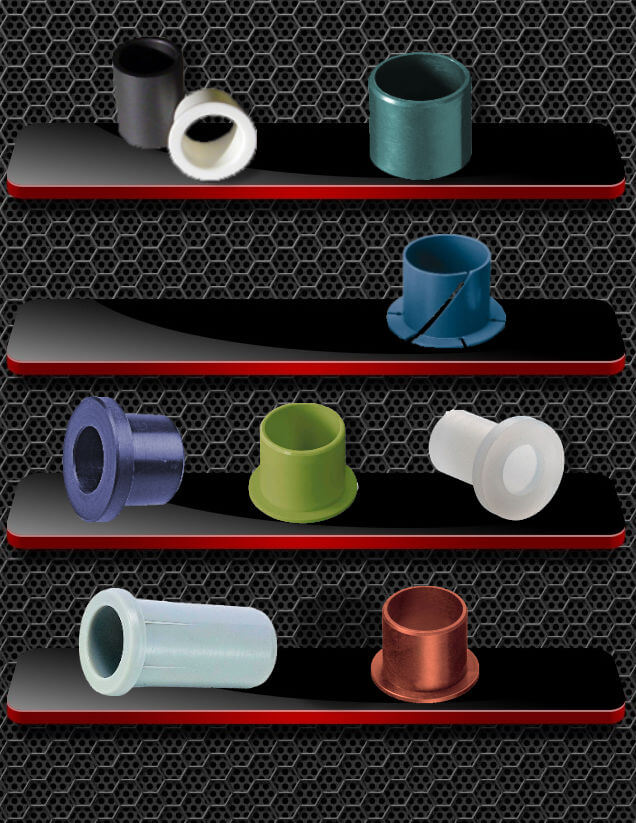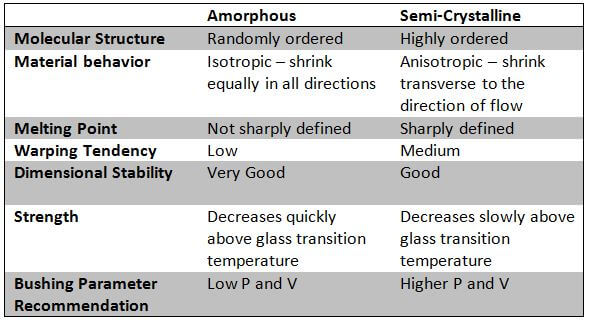Polymer Bushing Mechanisms of Wear
Bushings have two mechanisms of wear: adhesion and abrasive. Adhesion, as discussed in a previous post, occurs when two surfaces come into direct contact and the atoms from one surface adhere to the other surface. Abrasion occurs when a harder surface contacts a softer surface and removes material from the softer surface. For polymer bushings, the primary mode of wear is adhesion. The key to understanding wear by adhesion is a proper understanding of how polymers respond to friction.
Here are some other articles relating to polymer bushings and bearings from Advanced EMC Technologies:
- No More Beating around the Bushing
- Selecting the Precise Polymer Bushing
- Ultimate Qualitative Cheat Sheet for Polymer Bushing Life Expectancy
- Bearing Basics: Facts Your Boss Hopes You Know about Plain Polymer Bearings
Polymer Bushing Friction
Friction isn’t as easy to model for polymer bushings as one might initially think. First, we know that there is a difference between static friction and dynamic friction. We also know that frictional coefficients don’t necessarily stay the same during the entire lifetime of the part. To make matters more challenging, polymers don’t behave like metals when it comes to friction.
Both metal-on-metal, plastic-on-metal, and plastic-on-plastic interactions experience two kinds of friction: static friction and dynamic friction. Static friction is related to initiating motion, and dynamic friction is related to maintaining that motion. For metals, static friction is greater than dynamic friction. This translates into it requiring more force to get something moving than it does to keep it moving.
Plastics are the opposite: their dynamic friction is greater than their static friction. How does this affect wear? Plastics are subject to a phenomena of “stick and slip,” resulting in intermittent motion. This is what leads to adhesion as the primary wear mechanism for plastic bushings. This also results in friction, and thus wear, being much more dependent on the shaft speed V than on the specific bearing load P.
Glass Transition Temperature
We know that metals have a glass-transition temperature. If the operating temperature falls below the glass transition temperature, the metals behavior transitions from behaving as a ductile material to behaving as a brittle material. In fact, some people attribute the infamous sinking of the Titanic to the old, glacial waters causing the otherwise strong, ductile steel to fail upon an impact.
A similar mechanism can affect the behavior of polymers. Their viscoelasticity decreases drastically above their glass transition point, making them far less resistant to deformation at the same load. It is possible for frictional forces to generate enough heat to change the behavior of polymers with a low melting point. That’s why the thermal conductivity of polymers can be an important characteristic when selecting a bushing material. You want to conduct the heat away from the contacting surface as quickly as possible.
Polymers for Bushing Applications
So what kinds of polymers should be used for bushings to minimize friction and wear? The preferred choice is high temperature thermoplastic polymers, which are divided into amorphous and semi-crystalline plastics. The difference between these two is closely tied to how their molecular structure forms as they cool. Semi-crystalline plastics have a high ordered crystalline structure, while amorphous plastics have been liked to a steel wool pad.
The table below summarizes some of the features of these types of thermoplastics that are important to wear.
The semi-crystalline polymers are the more highly recommended of the two when it comes to wear. In addition to the characteristics listed above, they also perform well under sliding contact and have good fatigue properties.
Semi-crystalline thermoplastics that are commonly used in bushings include Nylon (PA) and high-temperature Nylon, Acetal (POM), PEEK, Teflon (PTFE) and Polyphenylene Sulfide (PPS). The most commonly used amorphous thermoplastic is polycarbonate (PC).
Properties of Importance
When choosing a thermoplastic for a bushing application, besides just the P, V, and PV ratings of the material, it’s a good idea to consider their melting point and glass transition temperature. You also need to check the material’s continuous use temperature. This property is tied in closely to overall performance of the polymer at an elevated temperature. Another useful property, if available, is the heat deflection temperature. Also known as the heat distortion temperature, it is a measure of the temperature at which a polymer deflects a specified amount at a specified load.
Conclusion – Polymer Bushings Differences
Polymers behave very differently from metal when it comes to wear, but are an ideal choice for many bushing applications as long as you understand the concepts behind the wear and tear of polymer bushings.
Check out Advanced EMC Technologies White Paper on polymer bearing design “Advanced Polymer Bearing Design.”


